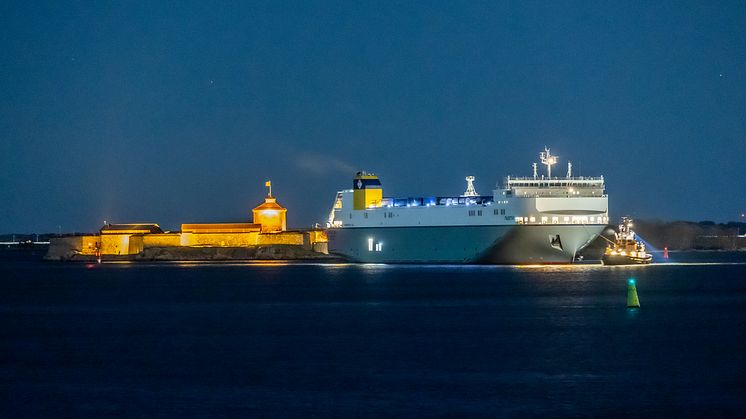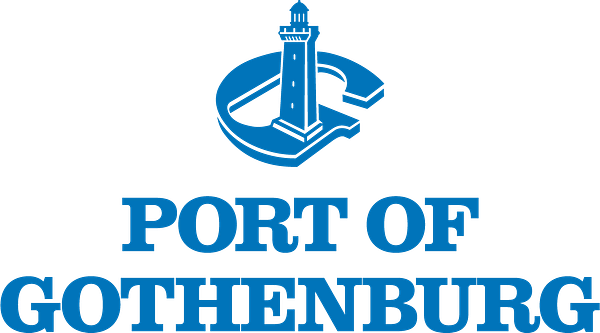
Press release -
Environment and efficiency benefits with new vessel on Gothenburg-Zeebrugge route
On Monday morning, shipping company CLdN's newly built vessel made her first call at the Port of Gothenburg. Faustine is the company's most advanced vessel and can be operated on liquefied natural gas or biogas. Now she will deploy the route between the Port of Gothenburg and Zeebrugge. Today, the ship will reach Zeebrugge loaded with Swedish export goods for the first time.
Faustine is the first of two vessels ordered by CLdN equipped with an LNG, high-pressure, two-stroke, dual-fuel propulsion system that can use liquefied natural gas or biogas (LNG/LBG) or diesel.
”We are investing in technologically advanced vessels to reduce climate impact, and Faustine is another step forward on our journey. She has the same capacity as her H5 sister vessels, but due to technical improvements we can optimize the cargo mix more efficiently,” said Emil Holmgren, Country Manager at CLdN.
Faustine calls at at Gothenburg Roro Terminal in the Port of Gothenburg and is deployed on CLdN's existing traffic between Gothenburg and Zeebrugge. It is an important destination for Swedish trade with Central Europe, where Zeebrugge is an important hub with a catchment area that includes the entire BeNeLux area, Germany and France. Swedish export goods are also transhipped at Belgian ports for further transport to other European ports in the United Kingdom, Spain or Ireland, to name a few. Cargo to and from Belgium include foodstuff, vehicles, industrial components, steel and forest products.
The Port of Gothenburg currently has a total of 12 departures to and from Belgium every week, including shipping companies DFDS and EML who are operating via the ports of Ghent and Zeebrugge.
”The importance of Belgian traffic for Swedish foreign trade can not be underestimated and it is very positive that CLdN continues to invest in a new, modern, efficient vessel with good environmental performance,” said Jacob Minnhagen, business developer at the Gothenburg Port Authority.
Faustine is the most recent example of LNG/LBG vessels that have started calling at the Port of Gothenburg to a greater extent in recent years. The fuel is most common in the tanker segment where many shipping companies use Gothenburg as a primary bunker hub for LNG and LBG.
The port has a long-term strategy to make alternative fuels more available to ships calling at the port. LNG and LBG are some examples, while methanol is another. The port has also started a feasibility study together with the Norwegian energy company Statkraft, where the goal is to start in-port production of hydrogen. In the long term, electric vessels will be delivered, where Stena Line is the closest with its Elektra vessels, which will start calling and charging at the Port of Gothenburg before 2030.
Fact sheet: M / V Faustine
Vessel type: Roro
Year of construction: 2021
Length: 216.47 m
Width: 32.26 m
Load capacity: 450 trailers and containers
Cargo decks: 5
Adjustable car decks: 2
Topics
Fact file: Port of Gothenburg
The Port of Gothenburg is the largest port in Scandinavia. Around 30% of Swedish domestic and foreign trade passes through the Port of Gothenburg and around 50% of all container traffic. The port is a full-service port, and offers industry guaranteed, climate-smart access to the whole world. Direct services to key markets ensure highly efficient, sustainable, and reliable transport 24 hours a day, 365 days a year. The focus is firmly on sustainability, innovation, and digitalisation in a concerted effort to maintain the ongoing development of climate-efficient freight transport and calls by vessels. With 25 rail shuttles offering daily departures, companies throughout Sweden and Norway have a direct, climate-neutral service to the Port of Gothenburg. The port operates energy product, vehicle, ro-ro, container, and passenger terminals and has 22,000 employees.
Follow us on:
Facebook
Instagram
LinkedIn
Twitter
www.portofgothenburg.com


